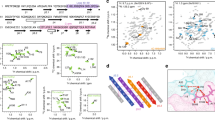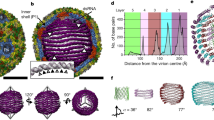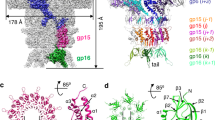Abstract
The critical viral components for packaging DNA, recognizing and binding to host cells, and injecting the condensed DNA into the host are organized at a single vertex of many icosahedral viruses. These component structures do not share icosahedral symmetry and cannot be resolved using a conventional icosahedral averaging method. Here we report the structure of the entire infectious Salmonella bacteriophage epsilon15 (ref. 1) determined from single-particle cryo-electron microscopy, without icosahedral averaging. This structure displays not only the icosahedral shell of 60 hexamers and 11 pentamers, but also the non-icosahedral components at one pentameric vertex. The densities at this vertex can be identified as the 12-subunit portal complex sandwiched between an internal cylindrical core and an external tail hub connecting to six projecting trimeric tailspikes. The viral genome is packed as coaxial coils in at least three outer layers with ∼90 terminal nucleotides extending through the protein core and the portal complex and poised for injection. The shell protein from icosahedral reconstruction at higher resolution exhibits a similar fold to that of other double-stranded DNA viruses including herpesvirus2,3,4,5,6, suggesting a common ancestor among these diverse viruses. The image reconstruction approach should be applicable to studying other biological nanomachines with components of mixed symmetries.
This is a preview of subscription content, access via your institution
Access options
Subscribe to this journal
Receive 51 print issues and online access
$199.00 per year
only $3.90 per issue
Buy this article
- Purchase on Springer Link
- Instant access to full article PDF
Prices may be subject to local taxes which are calculated during checkout




Similar content being viewed by others
References
McConnell, M., Reznick, A. & Wright, A. Studies on the initial interactions of bacteriophage epsilon15 with its host cell, Salmonella anatum. Virology 94, 10–23 (1979)
Jiang, W. et al. Coat protein fold and maturation transition of bacteriophage P22 seen at subnanometer resolutions. Nature Struct. Biol. 10, 131–135 (2003)
Wikoff, W. R. et al. Topologically linked protein rings in the bacteriophage HK97 capsid. Science 289, 2129–2133 (2000)
Fokine, A. et al. Structural and functional similarities between the capsid proteins of bacteriophages T4 and HK97 point to a common ancestry. Proc. Natl Acad. Sci. USA 102, 7163–7168 (2005)
Morais, M. C. et al. Conservation of the capsid structure in tailed dsDNA bacteriophages: the pseudoatomic structure of phi29. Mol. Cell 18, 149–159 (2005)
Baker, M. L., Jiang, W., Rixon, F. J. & Chiu, W. Common ancestry of herpesviruses and tailed DNA bacteriophages. J. Virol. 79, 14967–14970 (2005)
Breitbart, M., Rohwer, F. & Abedon, S. T. in Phages: their Role in Bacterial Pathogenesis and Biotechnology (eds Waldor, M. K., Friedman, D. I. & Adhya, S. L.) 66–91 (ASM Press, Washington DC, 2005)
Bazinet, C. & King, J. The DNA translocating vertex of dsDNA bacteriophage. Annu. Rev. Microbiol. 39, 109–129 (1985)
Smith, D. E. et al. The bacteriophage straight phi29 portal motor can package DNA against a large internal force. Nature 413, 748–752 (2001)
Earnshaw, W. C., King, J., Harrison, S. C. & Eiserling, F. A. The structural organization of DNA packaged within the heads of T4 wild-type, isometric and giant bacteriophages. Cell 14, 559–568 (1978)
Arsuaga, J., Tan, R. K., Vazquez, M., Sumners de, W. & Harvey, S. C. Investigation of viral DNA packaging using molecular mechanics models. Biophys. Chem. 101–102, 475–484 (2002)
Zhang, Z. et al. Visualization of the maturation transition in bacteriophage P22 by electron cryomicroscopy. J. Mol. Biol. 297, 615–626 (2000)
Cerritelli, M. E. et al. Encapsidated conformation of bacteriophage T7 DNA. Cell 91, 271–280 (1997)
Lurz, R. et al. Structural organisation of the head-to-tail interface of a bacterial virus. J. Mol. Biol. 310, 1027–1037 (2001)
Carazo, J. M., Fujisawa, H., Nakasu, S. & Carrascosa, J. L. Bacteriophage T3 gene 8 product oligomer structure. J. Ultrastruct. Mol. Struct. Res. 94, 105–113 (1986)
Simpson, A. A. et al. Structure of the bacteriophage phi29 DNA packaging motor. Nature 408, 745–750 (2000)
Orlova, E. V. et al. Structure of a viral DNA gatekeeper at 10 Å resolution by cryo-electron microscopy. EMBO J. 22, 1255–1262 (2003)
Agirrezabala, X. et al. Structure of the connector of bacteriophage T7 at 8 Å resolution: structural homologies of a basic component of a DNA translocating machinery. J. Mol. Biol. 347, 895–902 (2005)
Tang, L., Marion, W. R., Cingolani, G., Prevelige, P. E. & Johnson, J. E. Three-dimensional structure of the bacteriophage P22 tail machine. EMBO J. 24, 2087–2095 (2005)
Cerritelli, M. E. et al. A second symmetry mismatch at the portal vertex of bacteriophage T7: 8-fold symmetry in the procapsid core. J. Mol. Biol. 327, 1–6 (2003)
Molineux, I. J. No syringes please, ejection of phage T7 DNA from the virion is enzyme driven. Mol. Microbiol. 40, 1–8 (2001)
Tavares, P., Lurz, R., Stiege, A., Ruckert, B. & Trautner, T. A. Sequential headful packaging and fate of the cleaved DNA ends in bacteriophage SPP1. J. Mol. Biol. 264, 954–967 (1996)
Dubochet, J. et al. Cryo-electron microscopy of vitrified specimens. Q. Rev. Biophys. 21, 129–228 (1988)
Booth, C. R. et al. A 9 Å single particle reconstruction from CCD captured images on a 200 kV electron cryomicroscope. J. Struct. Biol. 147, 116–127 (2004)
Jiang, W. et al. Semi-automated icosahedral particle reconstruction at sub-nanometer resolution. J. Struct. Biol. 136, 214–225 (2001)
Ludtke, S. J., Baldwin, P. R. & Chiu, W. EMAN: semiautomated software for high-resolution single-particle reconstructions. J. Struct. Biol. 128, 82–97 (1999)
Jiang, W., Baker, M. L., Ludtke, S. J. & Chiu, W. Bridging the information gap: computational tools for intermediate resolution structure interpretation. J. Mol. Biol. 308, 1033–1044 (2001)
Pettersen, E. F. et al. UCSF Chimera—a visualization system for exploratory research and analysis. J. Comput. Chem. 25, 1605–1612 (2004)
Acknowledgements
We acknowledge the support of grants from National Institutes of Health and the Robert Welch Foundation. We thank M. Dougherty for the production of the animations, M. Baker for the AIRS program for secondary structure element identification, and M. F. Schmid and F. Rixon for discussions. Author Contributions W.J. developed the image processing methods and solved and analysed the structures; J.C. and J.J. collected the 200- and 300-kV image data respectively; P.W. did the biochemical preparation and analysis; and W.J., P.W., J.K. and W.C. interpreted the structure and wrote the manuscript.
Author information
Authors and Affiliations
Corresponding author
Ethics declarations
Competing interests
The three-dimensional density maps have been deposited into the EBI-MSD EMD database with accession codes EMD-1175 for the complete structure without symmetry imposition and EMD-1176 for the icosahedral shell structure. Reprints and permissions information is available at npg.nature.com/reprintsandpermissions. The authors declare no competing financial interests.
Supplementary information
Supplementary Methods
This file contains additional details on the methods used in this study, including purification of Epsilon15 phage, CryoEM imaging, 3-D icosahedral reconstruction 3-D non-icosahedral reconstruction and a structural analysis. (DOC 46 kb)
Supplementary Figures
Supplementary Figures 1–8 with accompanying legends. (PPT 12200 kb)
Supplementary Movie 1
The complete structure of Epsilon15 phage showing each of the structural components including tailspikes, tail hub, portal, core, dsDNA and shell proteins based on the 20 Å reconstruction with no symmetry imposed. (MPG 33850 kb)
Supplementary-Movie 2
The icosahedral reconstruction of Epsilon15 phage at 9.5 Å resolution showing the locations of the α-helices and β-sheets of the average capsid shell protein. (MPG 35257 kb)
Rights and permissions
About this article
Cite this article
Jiang, W., Chang, J., Jakana, J. et al. Structure of epsilon15 bacteriophage reveals genome organization and DNA packaging/injection apparatus. Nature 439, 612–616 (2006). https://doi.org/10.1038/nature04487
Received:
Accepted:
Issue Date:
DOI: https://doi.org/10.1038/nature04487
This article is cited by
-
Cryo-EM structure of a bacteriophage M13 mini variant
Nature Communications (2023)
-
Ultrastructure and fractal property of chromosomes in close-to-native yeast nuclei visualized using X-ray laser diffraction
Scientific Reports (2023)
-
Translation of the long-term fundamental studies on viral DNA packaging motors into nanotechnology and nanomedicine
Science China Life Sciences (2020)
-
Multiple liquid crystalline geometries of highly compacted nucleic acid in a dsRNA virus
Nature (2019)
-
Cryo-EM structures of herpes simplex virus type 1 portal vertex and packaged genome
Nature (2019)
Comments
By submitting a comment you agree to abide by our Terms and Community Guidelines. If you find something abusive or that does not comply with our terms or guidelines please flag it as inappropriate.



